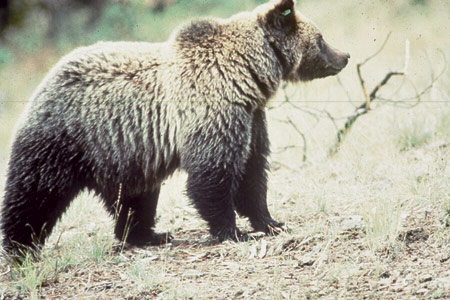With a proposal to remove grizzly bears from the Endangered Species List likely to be put forth in 2014, a management plan for most of Northwest Montana’s population is being drafted for public comment in the upcoming months, according to an official with the U.S. Fish and Wildlife Service.
Chris Servheen, a grizzly bear recovery coordinator for FWS, said a group of interagency wildlife representatives is developing a “post-delisting conservation strategy” for the grizzly population in the Northern Continental Divide Ecosystem. A draft of the proposed plan should be released for public comment in early 2013, Servheen said.
The plan, which could include a hunting season as a management tool, would only go into effect if grizzlies are delisted in the NCDE. The FWS and other agencies are likely going to propose the delisting by mid to late 2014 now that they believe the population has recovered and is sustainable.
“The NCDE population continues to remain healthy and mortalities were pretty low this year,” Servheen said.
The NCDE encompasses 7.75 million acres extending south from the Canadian border through the Flathead and Mission valleys to the Blackfoot River basin near Missoula. It is believed to be home to the largest grizzly population in the Lower 48, containing roughly 1,000 bears with an annual growth rate of 3 percent, according to the FWS. It does not include the Cabinet-Yaak ecosystem, which extends through the Cabinet and Purcell mountain ranges in Northwest Montana and Northern Idaho.
A proposal to delist grizzlies anywhere in the state would almost certainly stir up legal opposition once again from conservation groups that remain opposed to removing federal protection. Eight organizations banded together in a 2007 lawsuit opposing the delisting of grizzlies in the Yellowstone ecosystem. The U.S. Ninth District Circuit Court of Appeals sided with the organizations, citing the increasing loss of a vital food source, white-bark pine, due to climate change as a significant danger to grizzlies.
“We sued when they delisted grizzlies in Yellowstone and won, and we still think the same problems apply,” said Mike Garrity, the executive director of the Alliance for the Wild Rockies. “We don’t think grizzly bears should be delisted until they’re fully recovered and there are statutory regulations in place to make sure populations will remain stable.”
Garrity said grizzlies should not be delisted until all of the separate populations have recovered and are connected again. If the populations do not reconnect, allowing for new breeding opportunities, then they will not be genetically viable, he said.
“We think there should be a hands-off policy for awhile and let the populations recover,” Garrity said. “It would be stupid to go out and delist them when they’re not recovered and then open a hunting season so the population takes a dip again.”
Garrity added, “We’d love to see grizzly bears recovered and delisted but we want them to be delisted based on science, not politics.”
Servheen said that delisting a grizzly population would not change the intended goal of reconnecting the bears within the ecosystems.
“Our long-term vision is to see them all connected in a larger unit,” Servheen said.
“We’re following the law,” he added. “It’s taken us 30 years to get to this point. There’s been no rush to delist anything. It’s a very careful program that’s based on the best available science. It’s not influenced by any particular group at all. It’s influenced by the law.”
Servheen noted that the goal of the Endangered Species Act is to help wildlife populations recover so that they can eventually be delisted; it is not intended to be a permanent designation, he said.
The status of grizzly bear populations and their future in and around Montana were the focal points at last week’s bi-annual three-day meeting in Missoula for the Interagency Grizzly Bear Committee. The IGBC was formed in 1983, eight years after grizzlies were placed under federal protection, to focus on the recovery of the endangered animal through policy, planning, management and research. The IGBC includes a collective of representatives from FWS, U.S. Forest Service, National Park Service, Bureau of Land Management, U.S. Geological Survey and state wildlife agencies in Montana, Idaho, Washington, Wyoming as well as the Canadian Wildlife Service.
 |
|
A grizzly bear near Yellowstone National Park. | Photo courtesy U.S. Fish and Wildlife Service |
The main topic of conversation that emerged from the latest meeting was the possibility of future trophy hunts for grizzlies. The IGBC decided that a hunting season for grizzlies should be included in a post-delisting management strategy.
A statement from the committee read: “In recovered and delisted grizzly bear populations, the Interagency Grizzly Bear Committee supports the use of regulated hunting following the principles of the North American Model of Wildlife Conservation as one approach to help manage numbers and distribution of bears to promote coexistence and help minimize conflict.”
The specifics of a possible hunting season remain unclear and Servheen said the subject remains in the very early stages of discussion.
Presenters at the IGBC meeting also discussed the research being conducted in the Cabinet-Yaak ecosystem, which is home to a small population of roughly 45-50 grizzlies. Researchers are continuing work on a population study that involved collecting hair samples. DNA from those samples is currently being analyzed, Servheen said.
Researchers are also studying changes in food supply and the health of the bear population in the Yellowstone ecosystem. That report could be presented in a year, Servheen said.